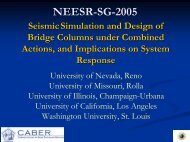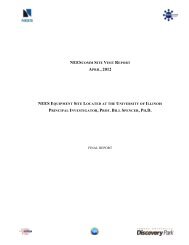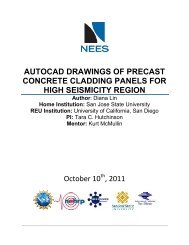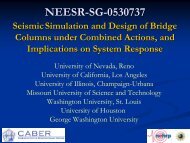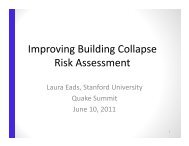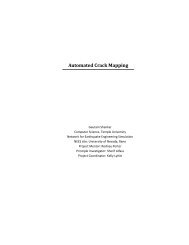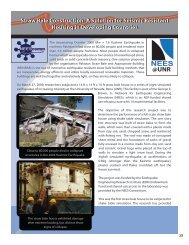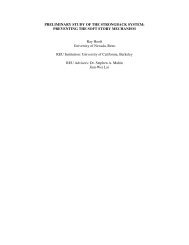TSUNAMI WAVE BREAKING BEHAVIOR ON A REEF WITH A ...
TSUNAMI WAVE BREAKING BEHAVIOR ON A REEF WITH A ...
TSUNAMI WAVE BREAKING BEHAVIOR ON A REEF WITH A ...
You also want an ePaper? Increase the reach of your titles
YUMPU automatically turns print PDFs into web optimized ePapers that Google loves.
1. Abstract<br />
This study is part of the University of Hawaii at Manoa’s HI<strong>REEF</strong> 2 project and aims to analyze the<br />
breaking behavior of tsunami waves over a reef shape similar to the ones present on tropical islands like<br />
Hawaii. In addition, energy dissipation due to bottom roughness was investigated and proven to be<br />
significant. When roughness was in the zone before breaking, waves were smaller, broke sooner, and<br />
crashed sooner than waves that propagated over roughness which had been placed after breaking.<br />
When looking at breaking characteristics in comparison to previous research where only a mild slope<br />
was considered, the waves in this experiment had a higher breaking index (wave height at<br />
breaking/water depth at breaking) and a lower water depth at breaking due to the geometry of the<br />
bottom surface, indicating that bathymetry plays a role in wave breaking. In the future, better<br />
understanding of the breaking behavior and energy dissipation of tsunami waves due to roughness and<br />
reef geometry will lead to more accurate numerical models that can then be used as engineering tools<br />
to save both infrastructure and lives in tsunami hazard zones.<br />
2. Introduction and Literature Review<br />
Tsunamis occur when underwater earthquakes, landslides, or volcanic eruptions create massive<br />
displacements of water that travel towards the shore at alarming speeds. When these massive waves<br />
reach the coastline, they are capable of causing enormous damage to infrastructure and killing<br />
thousands of people. It is crucial that we study tsunami events and wave propagation not only to<br />
improve our understanding of the phenomena, but so we can create improved building codes that can<br />
lead to enhancing human safety and improving our coastal management. The HI<strong>REEF</strong> 2 project is aimed<br />
at studying how tsunamis and structures are affected by bathymetry specific to the Hawaiian region and<br />
other islands. This particular part of the HI<strong>REEF</strong> project works to understand the effect of roughness and<br />
reef geometry on the breaking of these waves. By observing the wave breaking characteristics, the wave<br />
energy dissipation due to roughness and geometry can be estimated.<br />
Tsunamis are characterized by long wave lengths, and can<br />
therefore be simply modeled as solitary waves with<br />
theoretically infinite wavelengths (Young et al 2008). The<br />
hydrodynamic similarities between these two types of<br />
waves have been proven and solitary waves are therefore<br />
used in most experiments relating to tsunamis, including<br />
this one. This experiment differs from previously<br />
completed studies by Grilli et al. (1997) in that roughness is<br />
introduced by using timber planks installed in the bottom of<br />
the wave flume, as well as island reef bathymetry as seen by<br />
the steep slope and flat reef configuration of the tank.<br />
Figure 1: Bathymetry of the Hawaiian Islands.<br />
(SOEST, 2009)<br />
2






